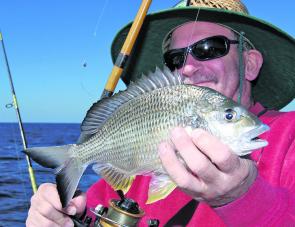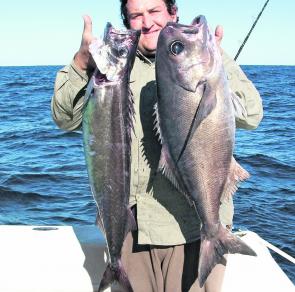Cold and windy, sometimes wet and mostly miserable pretty much sums up July.
Being an optimist is part of the fishing game, otherwise we wouldn’t get out of bed in these conditions.
One good thing is we are now past the shortest day, so with each passing day we get one step closer to Summer. But for the moment, we have to play with the cards we are dealt and it is not all doom and gloom.
Over coming weeks the cuttlefish will hit peak spawning mode and this means hungry snapper looking for an easy feed.
It happens every year. First, the divers see the cuttlefish gaining in numbers over the inshore reefs, then the albatrosses, or what is left of their species, fly in from all parts of the southern ocean ready for the feast.
Then, when the water and the moon get just right, usually around the second week in July, the cuttlies get stuck into it and, like the salmon of the Northern Hemisphere, they die after spawning.
Because of their buoyant shells, their bodies float to the surface. Then the fish and the birds get stuck in for about a month and it’s all over.
You will get plenty of early reds in the weeks prior to the main event and they will hunt the cuttlies.
But they also like a bit of easy tucker so you can score a feed of snapper by setting up a berley trail over one of the local shallow reefs and fishing unweighted cuttlefish strips, fish pieces or pilchards.
Most of the reds will be schoolies up to 2 kilos but a few big bruisers will be in the mix.
While you are at anchor, drop a live yellowtail or slimy mackerel to the bottom to catch a king, jewie or big red. But even a sweep will do, because the real aim is to catch a cuttlefish.
A cuttlie will hang on tight to just about anything alive and you can get it right to the top and net it.
This is when the fun starts; they have all that black ink, they know how to aim it and it sticks like the proverbial to a blanket. If you think squid ink is bad, this stuff is squid ink on steroids!
One standard cuttlefish will give you enough bait for half a dozen trips and you get the best bits, the candles, intact. The candles are the cuttlefish’s two tentacles; the other eight appendages are officially legs.
When the cuttlefish dies and pops to the top, the first things to disappear are the candles because they are the tenderest parts. They are often gone before they hit the surface because snapper love them, as do kings.
Soft plastic lures work, too, and can be effective in the lead-up to the main cuttlefish run. Once the reds become focused on cuttlefish you can fish the reefs randomly, working the edges, or switch to sight fishing with bait or very lightly rigged plastics.
You may get a screaming run on a cuttlefish bait when chasing reds and be put through the reef in seconds by an unstoppable fish. The culprit will probably be a big blue groper.
There are still a few fishos who chase the Winter groper and it isn’t a bad option on a very calm westerly day when the snapper are just too touchy.
There are plenty over every reef these days and a little time put in catching crabs during the evening will pay off the next day.
You are allowed only two groper per person per day but one per boat is a much better option; one good fish goes a long way. Or you can just let them go – a big blue is a beautiful fish.
Silver trevally will pick up in numbers over coming weeks and they love a good berley trail, too. The islands and Bass Point close in are great spots.
Casting unweighted ganged pilchards into the washes around the islands and bommies will throw up a few surprises.
It will mostly be a procession of salmon and tailor, but a few nice snapper and the odd monster bream will be around the whitewater as well. Maybe even a king to keep you on your toes.
Casting very lightly weighted cunjevoi or royal red prawns into the same spots will yield some thumper black and silver drummer, heaps of bream, trevally and some more salmon.
For the drifters there are plenty of smaller snapper around the reefs and gravel in close but the flatties have gone a bit quiet after their burst in late May and June when the warm water hung around a bit.
Throw in some nice black spot pigfish and heaps of leatherjackets and there is still enough to keep you interested.
Late in the month there might even be a few early striped tuna turning up in close to throw lures at but they should start to pick up in numbers further offshore.
Yellowfin tuna may be around as well as some big bluefin but it has been a strange sort of year so far, with very limited yellowfin and no word on the bluefin – but that can change in a day.
A few albacore have picked up small trolled skirts and Christmas trees out on the continental shelf.
There are reports of plenty of gemfish and a few blue-eye around the Kiama Canyons if the weather and current permit, and you like winding in 250m-plus of line each drop.
Back on the rocks there are more salmon for the pillie-tossers and bream, and drummer in the washes on royal reds.
Try berleying with bread and fishing the prawns under a small bobby cork. This method at least gives you a chance at getting some line on the big drummer, rather than waiting for the line to go tight and they reef you before you can even strike.
Most platforms have all species but for salmon, try the front of Windang Island, Cathedral Rocks or Marsdens at Kiama.
If you want to get adventurous for drummer, head to the rocks at the northern end of Coalcliff Beach and north towards Stanwell Park and pick your spot.
No rock ledge can ever be classed as safe but there are a few good ones here, but you have to work to get to them. Therefore they are rarely fished.
The beach jewies seem to be tapering off but a few are around if you like freezing on a beach in the middle of the night. You soon warm up when a metre-and-a-half slab of gold lights up in the torch beam in the wash at your feet.
There are always salmon and a few solid tailor during the evenings on most beaches, with bream in the gutters on slimy mackerel pieces if you can get some. Cuttlefish is good bait on the beaches at this time, too.
Lake Illawarra and the Minnamurra are very quiet apart from a few bream in the deeper holes and up in the lake feeder streams.
If all else fails and you want to keep relatively warm and dry in a safe place, you can chase squid in the harbours on a cold July evening.
Reads: 2947
There are plenty of snapper like this chasing cuttlefish this month.

There will be some quality bream in the washes and on the beaches.

Bottom-bouncing the Kiama Canyons will get you some deep-water ooglies like this gemfish and blue-eye trevalla.




